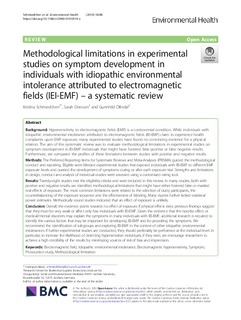| dc.contributor.author | Schmiedchen, Kristina | |
| dc.contributor.author | Driessen, Sarah | |
| dc.contributor.author | Oftedal, Gunnhild | |
| dc.date.accessioned | 2019-12-05T08:49:01Z | |
| dc.date.available | 2019-12-05T08:49:01Z | |
| dc.date.created | 2019-11-09T14:35:39Z | |
| dc.date.issued | 2019 | |
| dc.identifier.citation | Environmental health. 2019, 18:88 1-24. | nb_NO |
| dc.identifier.issn | 1476-069X | |
| dc.identifier.uri | http://hdl.handle.net/11250/2631865 | |
| dc.description.abstract | Background
Hypersensitivity to electromagnetic fields (EMF) is a controversial condition. While individuals with idiopathic environmental intolerance attributed to electromagnetic fields (IEI-EMF) claim to experience health complaints upon EMF exposure, many experimental studies have found no convincing evidence for a physical relation. The aim of this systematic review was to evaluate methodological limitations in experimental studies on symptom development in IEI-EMF individuals that might have fostered false positive or false negative results. Furthermore, we compared the profiles of these limitations between studies with positive and negative results.
Methods
The Preferred Reporting Items for Systematic Reviews and Meta-Analyses (PRISMA) guided the methodological conduct and reporting. Eligible were blinded experimental studies that exposed individuals with IEI-EMF to different EMF exposure levels and queried the development of symptoms during or after each exposure trial. Strengths and limitations in design, conduct and analysis of individual studies were assessed using a customized rating tool.
Results
Twenty-eight studies met the eligibility criteria and were included in this review. In many studies, both with positive and negative results, we identified methodological limitations that might have either fostered false or masked real effects of exposure. The most common limitations were related to the selection of study participants, the counterbalancing of the exposure sequence and the effectiveness of blinding. Many studies further lacked statistical power estimates. Methodically sound studies indicated that an effect of exposure is unlikely.
Conclusion
Overall, the evidence points towards no effect of exposure. If physical effects exist, previous findings suggest that they must be very weak or affect only few individuals with IEI-EMF. Given the evidence that the nocebo effect or medical/mental disorders may explain the symptoms in many individuals with IEI-EMF, additional research is required to identify the various factors that may be important for developing IEI-EMF and for provoking the symptoms. We recommend the identification of subgroups and exploring IEI-EMF in the context of other idiopathic environmental intolerances. If further experimental studies are conducted, they should preferably be performed at the individual level. In particular, to increase the likelihood of detecting hypersensitive individuals, if they exist, we encourage researchers to achieve a high credibility of the results by minimizing sources of risk of bias and imprecision. | nb_NO |
| dc.language.iso | eng | nb_NO |
| dc.publisher | BioMed Central | nb_NO |
| dc.rights | Navngivelse 4.0 Internasjonal | * |
| dc.rights.uri | http://creativecommons.org/licenses/by/4.0/deed.no | * |
| dc.title | Methodological limitations in experimental studies on symptom development in individuals with idiopathic environmental intolerance attributed to electromagnetic fields (IEI-EMF) - a systematic review | nb_NO |
| dc.type | Journal article | nb_NO |
| dc.type | Peer reviewed | nb_NO |
| dc.description.version | publishedVersion | nb_NO |
| dc.source.pagenumber | 1-24 | nb_NO |
| dc.source.volume | 18:88 | nb_NO |
| dc.source.journal | Environmental health | nb_NO |
| dc.identifier.doi | 10.1186/s12940-019-0519-x | |
| dc.identifier.cristin | 1745638 | |
| dc.description.localcode | Open Access This article is distributed under the terms of the Creative Commons Attribution 4.0 International License (http://creativecommons.org/licenses/by/4.0/), which permits unrestricted use, distribution, and reproduction in any medium, provided you give appropriate credit to the original author(s) and the source, provide a link to the Creative Commons license, and indicate if changes were made. The Creative Commons Public Domain Dedication waiver (http://creativecommons.org/publicdomain/zero/1.0/) applies to the data made available in this article, unless otherwise stated. | nb_NO |
| cristin.unitcode | 194,63,35,0 | |
| cristin.unitname | Institutt for elektroniske systemer | |
| cristin.ispublished | true | |
| cristin.fulltext | original | |
| cristin.qualitycode | 1 | |

